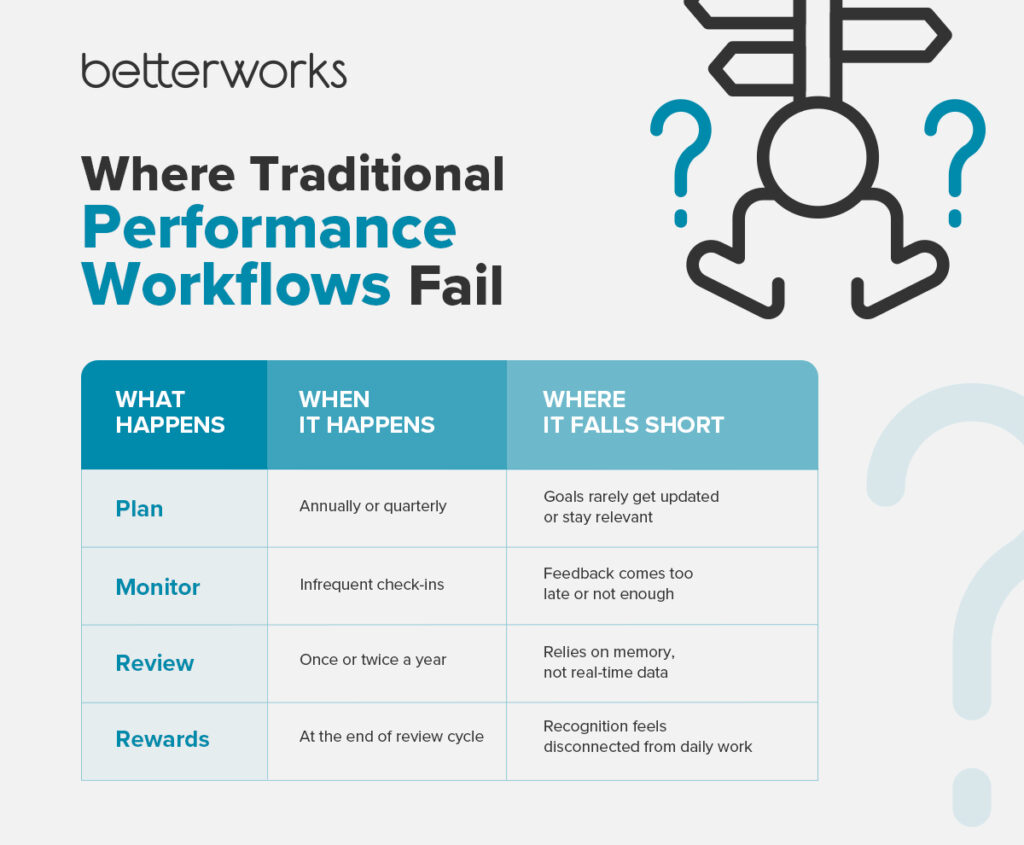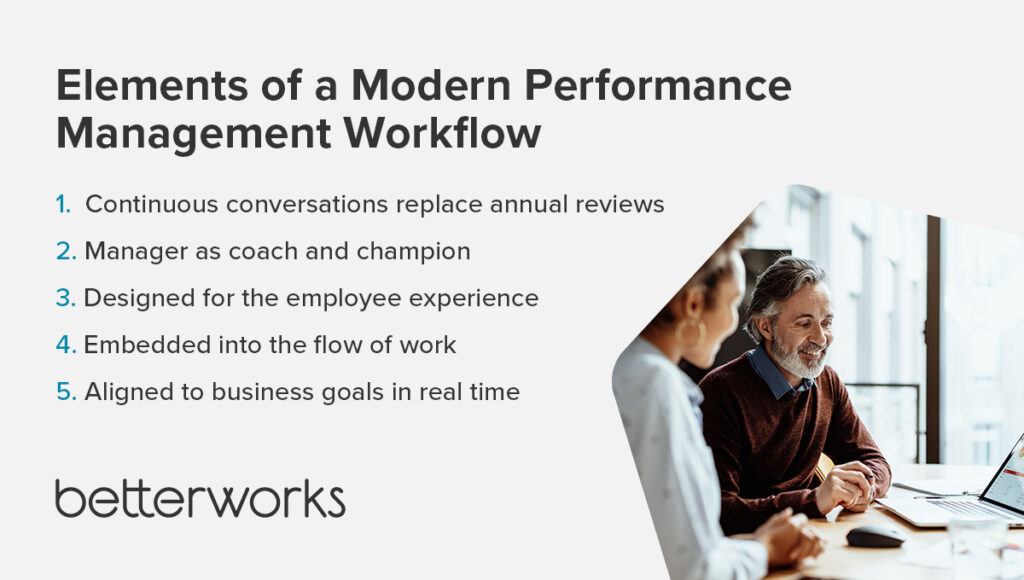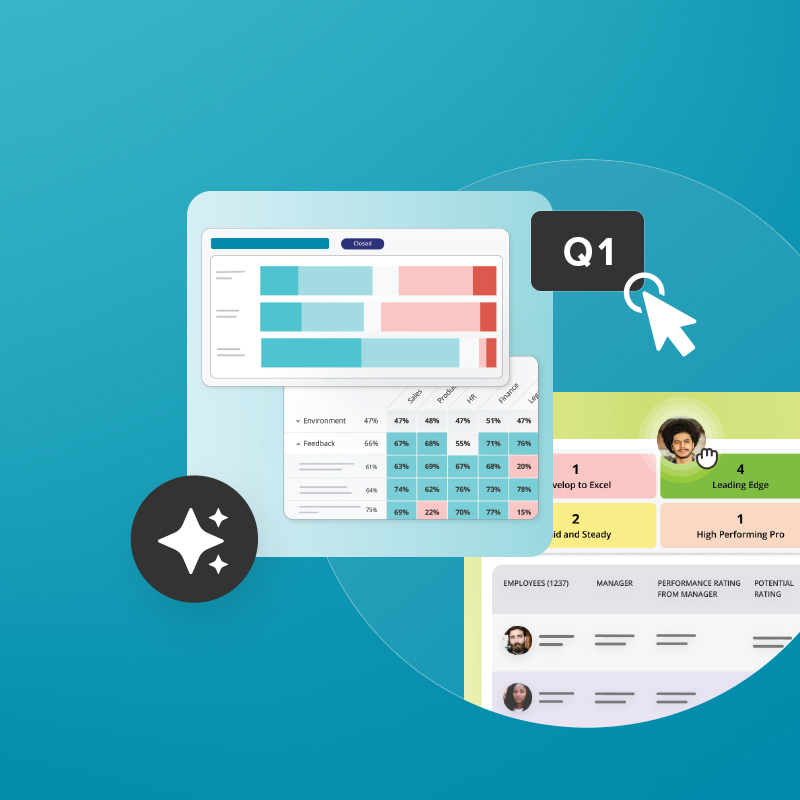- What Is a Performance Management Workflow?
- Why Traditional Performance Review Workflows No Longer Work
- What a modern performance management workflow looks like
- How to design a scalable performance management workflow
- Build a performance management system that works
- FAQ
- What are the 5 steps of the performance management process?
- How can AI be used in performance management workflows?
- What are the 5 C’s of performance management?
- What are the 4 phases of performance management?
- Why are traditional performance reviews ineffective?
- How often should performance conversations occur?
The traditional performance management workflow was built for a different era. It was designed around rigid hierarchies, where annual reviews fit the pace of work and long-term planning rarely shifted.
But work has changed. Teams move quickly, goals shift often, and performance can’t be managed on a delay. Feedback needs to be fast and contextual. When conversations are infrequent or removed from the day-to-day, they lose relevance, and people start to disengage.
It’s time to move on from static, compliance-led cycles that no longer serve the way we work. A modern performance management workflow creates continuous alignment, builds trust through meaningful conversations, and drives tangible business outcomes.
What Is a Performance Management Workflow?
A performance management workflow is the system or process organizations use to set expectations, track progress, provide feedback, and evaluate employee performance. At its core, it guides how managers and employees work together to achieve individual and company goals.
Traditionally, this workflow follows a familiar cycle: plan, monitor, review, and reward. Organizations set goals, track progress, conduct formal reviews once or twice a year, and then recognize or reward performance based on those evaluations.
This model persists because it feels familiar and offers a sense of control. But today’s workforce needs a more flexible, real-time approach than rigid, infrequent reviews can provide.
“If you want to find good people and retain good people, being talked to once or twice a year about how you’re performing in the rearview mirror isn’t going to cut it,” Betterworks CEO Doug Dennerline shares on the Punk Rock HR podcast,
Why Traditional Performance Review Workflows No Longer Work
Annual reviews don’t fit the shape or speed of modern work. Transitioning between projects, cross-funtional work, non-linear career paths, and shifting priorities are now the norm. This means that when feedback is slow or reviews are forced into siloed conversations, they fail to capture real-time progress and challenges employees face.
Jamie Aitken, vice president of HR transformation at Betterworks, notes how this causes both challenges and achievements to slip through the cracks. “If I’m an individual and I’m in a traditional performance management conversation once or twice a year … my boss is going to be looking at maybe three months if they can remember, five months if they’ve taken notes all the time,” she says. “There’s a huge recency issue there.”
Traditional performance management approaches also place managers in the role of judge rather than coach. They are there to evaluate and grade rather than support. This creates a barrier to honest, two-way conversations.
On top of that, impersonal systems turn performance management into primarily a compliance exercise. Imagine being asked to complete a 10-page form about things that happened months ago when you’re already juggling a full schedule. Reviews become an irritating bureaucracy, not an opportunity to learn and grow.

What a modern performance management workflow looks like
A modern performance management workflow doesn’t revolve around ratings and rewards, rankings, or rearview-mirror performance discussions. Instead, it’s designed to support agility, unlock manager potential, and keep employees focused and connected through continuous conversations and real-time alignment.
In fact, it’s really not “management” at all. It’s about performance enablement. This shift moves the focus from control and evaluation to empowerment and growth.
Continuous conversations replace annual reviews
Continuous performance management conversations are the backbone of modern performance workflows. Unlike annual reviews, these feedback loops happen in real time, allowing employees to receive actionable insights when they matter most. Frequent touchpoints, whether weekly, monthly, or quarterly, help employees grow and stay aligned with evolving goals.
However, it’s also important to note that “continuous” doesn’t mean constant. It’s not about overwhelming employees with nonstop check-ins. Instead, it’s a structured cadence of meaningful dialogue, supported by feedback tools that make growth a natural part of the workday.

Manager as coach and champion
In this model, managers guide performance, rather than just grading it periodically. They become coaches and champions, encouraging growth through ongoing feedback, recognition, and career development conversations. This approach builds trust and helps employees feel genuinely supported.
Designed for the employee experience
Empathy is embedded in the design of the performance workflow. Instead of bureaucratic tasks, the process creates meaningful moments that matter, fostering motivation, well-being, and connection.
Integrated into the flow of work
Modern workflows integrate seamlessly with the tools teams already use, such as Slack, Microsoft Teams, Jira, and Salesforce. This reduces friction, making performance conversations a natural part of the workday rather than an interruption.
Aligned to business goals in real time
Goal setting is dynamic and transparent. Individuals and teams have visibility into progress toward what truly matters, not just what is easy to measure.
AI for HR can help facilitate this shift. Betterworks’ 2025 The State of Performance Enablement report found that 89% of employees whose performance process includes AI report high satisfaction. By using AI to analyze real-time feedback and goal progress, HR leaders gain actionable insights that improve alignment, engagement, and overall performance.

How to design a scalable performance management workflow
Designing a performance management workflow isn’t just about choosing the right tool or setting the right cadence. It’s about creating a system that supports how work actually happens — fast, cross-functional, and deeply human. The right workflow builds clarity, enables growth, and links every employee’s effort to real business outcomes.
Start with business problems, not HR processes
Workflows should be aligned with the company priorities, not the other way around. “Tell me what the problems that you’re trying to solve for the business are… then we’ll design the process,” Jamie says.
Make the workflow simple enough to use — and useful enough to keep
Adoption depends on simplicity and relevance. Using configurable templates makes the process easier for managers and employees while capturing consistent data over time.
Build for continuous conversations, not one-time reviews
Create rhythm and momentum with frequent, lightweight check-ins that make space for ongoing growth and real-time alignment.
Empower managers as coaches, not middlemen
Give managers the tools and permission to lead, not just report. Shift their mindset from gatekeepers to coaches who actively support their teams and improve work performance.
Design with empathy for the end user
Co-design workflows with employees, not just for them. Applying design thinking helps uncover real pain points and create moments that truly matter.
Build a performance management system that works
Rigid review cycles no longer serve your teams or your business. This is the moment to adopt agile performance management workflows that drive real growth, foster clear alignment, and strengthen retention.
Jamie highlights the urgency facing HR professionals and organizations: “This is the time for us to actually answer the call,” she stresses, adding, “There’s a longing for people to feel connected to the goals of an organization and to see how they contribute to what the organization is trying to achieve.”
By embracing agility, continuous alignment, and authentic connection, you create a performance enablement system that drives meaningful business outcomes and unlocks the full potential of your workforce.
Learn more by exploring the elements that comprise modern performance management.
FAQ
What are the 5 steps of the performance management process?
The traditional 5-step performance management process includes:
- Planning objectives
- Monitoring performance
- Reviewing outcomes
- Rating performance
- Rewarding results
Betterworks empowers organizations to stay agile by aligning goals continuously, enabling real-time feedback loops, fostering proactive coaching, adapting objectives as conditions shift, and using predictive analytics to drive sustained performance and growth.
How can AI be used in performance management workflows?
AI enhances performance management by delivering real-time insights that predict employee engagement, identify flight risks, and highlight biases early. It automates conversation prompts, integrates nudges directly into collaboration tools, and helps managers proactively coach employees.
What are the 5 C’s of performance management?
The 5 C’s of effective performance management are:
- Clarity (clear expectations and goals)
- Communication (ongoing feedback)
- Coaching (proactive development)
- Consistency (fairness and transparency)
- Continuous improvement (regular goal adjustment)
Betterworks technology supports these essentials, empowering managers and engaging employees in real-time to drive measurable growth.
What are the 4 phases of performance management?
The conventional 4-phase model includes:
- Planning (setting objectives)
- Monitoring (tracking performance)
- Reviewing (evaluating outcomes)
- Rewarding (recognizing accomplishments)
Betterworks transforms this into an ongoing cycle: continuously align around goals, activate regular feedback, coach through guided conversations, and adjust objectives in real-time, empowering managers and engaging employees for greater business agility.
Why are traditional performance reviews ineffective?
Traditional performance reviews occur too infrequently, rely on outdated information, and position managers as judges rather than coaches — resulting in employee disengagement and missed opportunities for growth.
How often should performance conversations occur?
Performance conversations should happen continuously in the flow of work. Daily or weekly check-ins embedded directly into everyday tools ensure real-time alignment, immediate feedback, and ongoing employee development.
Time to switch to modern performance management




